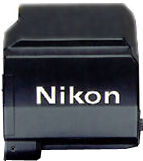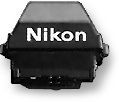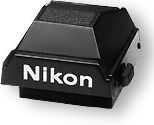There are five regular
production viewfinders available in the Nikon F3 system for you to handle every conceivable
photographic need a pro may encounter. And since the F3's SPD metering cell is locate
in the camera body, automatic and manual exposure control with complete viewfinder
displays are possible with every F3 finder. Each finder has its own miniature optical
system that projects the display uninverted and outside the picture area for maximum
legibility. All finders for F3 (with the single exception of the DX-1 Autofocus Finder
which only shows 93%) offer virtually 100% viewfinder field coverage.
Special prisms such
as the huge and irregularly looking autofocus finder DX-1, designed specifically for
the F3AF camera, can also be used as a supplementary prism or viewing aid on any
Nikon F3 body (Other than F3H & F3P), as it will act as an electronic rangefinder.
i.e. it indicates in or out of focus arrows in the viewfinder, providing a visual
aid to the photographer. Another viewfinder prism is a DE-4 - a titanium version of
the DE-3 High Eyepoint finder that came as a standard finder when you purchased the
F3T, it comes either in Champaign chrome finish during early days or the in black
finish after 1984.
 |
DX-1 Finder, the standard finder for
F3
AF camera
Big, odd looking
finder... BUT it is a detachable prism used on Nikon's first Autofocus SLR, the Nikon
F3AF camera. You can still use this finder on the regular F3 body and it will serve as an
electronic rangefinder to provide focusing aid as long as an AI lenses is used and
has an aperture larger than f3.5.
|
With the F3AF, one needs
to use the specially designed fixed focusing screen at the base of F3AF DX-1 finder,
which is non-interchangeable type (There is no need to mount a screen on the camera
body). Warning: The DX-1 Finder is not advisable to use on Nikon F3P, F3 LE
(Japanese local version of the F3P) and F3H. Further, it shows only 93% of the picture
frame instead of the usual 100% with other prisms for F3. The
SPDs built-in DX-1 Finder operable with a minimum brightness range from approx. EV4
(fl.4 at 1/8 sec. with 50mm fl.4 at ASA/ISO 100 on autofocus/focus-aid).
 |
The DX-1 is also referred
to as the world's first interchangeable autofocus finder and may be used with any Nikon
F3 camera (Other than F3H) for provide quick, in-focus verification (not autofocus)
in manual focus operation (Nikon called it an "Electronic Rangefinder").
It is also the only finder among all the few options available for the Nikon F3 that
require battery (2 x AAA cells) to function.
|
The
most unusual viewfinder (Looks normal but 'odd' on a standard F3) is the DE-5 Finder, a High-Eyepoint design type
that comes as standard finder with Nikon F3P ('P'
for "press") - a special production F3 that was specially tailored,
based on input from photojournalists, news and pixmen in the working
field.
 |
 |
It is the one and only
* F3 viewfinder prism that has a standard accessory
shoe on top that allows the use of common non-dedicated flash units that have a standard
ISO hot shoe flash foot.
* (Prior to a special
edition of F3P camera in Japan that termed as F3 Limited version in 1994 and the Nikon
F3 High speed Motor camera
in 1996/1997)
|
As you can notice from news conference, not all journalists use Nikon dedicated flash(units)
- even if it offers an absolute advantage of TTL flash exposure control. Well, with
this prism - TTL
flash exposure control is NOT POSSIBLE,
you have to either use auto flash or manual flash mode on the finder's standard
ISO-type accessory shoe (TTL is only possible via the 'normal' F3 accessory shoe
with Nikon TTL flash). However, most of these non-regular production prisms were
designed as a 'bundled' unit with camera models which served some specific function.
Although in general, these 'special' prisms are compatible with a regular Nikon F3
body, before you attempt to use one on your camera body, please refer to the respective
specification sheet for other compatibility issues.
Standard Eye-Level Finder
 |
 |
The DE- 2
was the only eyelevel finder that came with the Nikon F3 during the early days before
the High Eyepoint model DE-3 was introduced in 1982. It affords a slightly more compact
camera profile. Projects a fairly large image view with 0.8X magnification with the
50mm lens set at infinity.
|
 |
It was silver-coated inside
the pentaprism to provide an extraordinarily brilliant, clear image with good corner-to-corner
visibility. The eyepiece is rubber-cushioned for comfortable viewing and prevents
scratching of eyeglasses. A built-in eyepiece shutter prevents strong extraneous
light from affecting meter accuracy when your eye is away from the finder (as in
self-timer use or remote operation).
|
It uses DK-4 Rubber
Eyecup for comfort viewing, but the eyecup was not very well designed and often dropped
off, Nikon subsequently redesigned a locking system in the DK-2 for the High Eyepoint
Finder and it was marvellous, I have not changed an eyecup for more than 12 years !
High-Eyepoint Finder
DE-3 (DE-4
for Titanium version) The High-Eyepoint finder was made as a standard prism on
Nikon F3 in later years, including variants such as Nikon F3T (Titan) which has a similar finder made of
one of the best known industrial metals, titanium.
 |
 |
The finder with
the tough metal is referred to as DE-4, but it is NOT available as an optional
accessory for the regular F3. Some of the commercial photographic books stated HP
finder was made available in 1983. However, contradictory they also mentioned the
F3 Titan was introduced in 1982 - with a DE-4 finder which essentially is a DE-3
in titanium outfit. Well, I would love to believe it was in both in 1983, the year
when I bought my F3T.
|
 |
Technical highlight
of this prism is - the entire frame, including exposure information, is visible with
the eye up to 25mm (approx. 1 inch) away from the eyepiece. 0.75X magnification with
the 50mm lens focused at infinity. This provides certain degree of eye relief for
extended shooting sessions. But on a more practical note, for those glass wearers,
shooting behind a protective helmet or even wearing goggles or protective mask
(In this case, the action finder should be more functional), this should come in
very handy and useful.
|
It also has an Eyepiece
Shutter built in. If you have already owned a DE-2 eyelevel finder, you don't
have to rush out to buy a High Eyepoint Finder - other than if you think the High-Eyepoint
feature will benefit you a lot, because other than that - the high eye point finder
has no other significant purpose to justification the expense. Some would say, ahh... it looks
better which I might agree but don't intend to argue too much if we are talking about
justification for the amount you have to spend for the extra. No doubt the High Eyepoint
finder Looks more like a perfect match in the exterior appearance with an F3, but
inside the viewfinder, the reality of High Eyepoint also means you will have to live
with a smaller magnification than the regular DE-2 finder's 0.8X magnification (This
means smaller image will project inside the viewfinder). Other than these two elements
which might be useful or don't depend on personal needs, there are no
significant advantages over the standard eye level DE-2 finder. Personal suggestion: Consider fixing a DK-2 Rubber Eyecup onto your
High Eyepoint finder, it should be a good companion for viewing and focusing, with
or without wearing glasses.
| Previous
| Next | 3/4 Speed finder and MORE....
| Back |
Index Page of F3 Prisms
| Back |
Main Index Page of Nikon F3 models
 |
Home - Photography in Malaysia |










